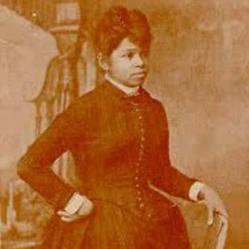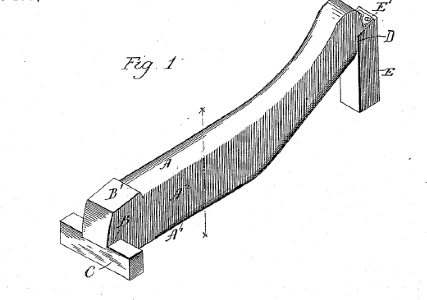In honor of Black History Month, IPWatchdog will be featuring profiles of black women inventors—some of whom are little-known and many of whom never profited from their inventions—throughout the month of February.
Sarah Boone is believed to be the fifth African-American woman to be awarded a U.S. patent Her invention, U.S. Patent No. 473,653, issued in 1892 and was directed to an improved ironing board. The object of her invention was “to produce a cheap, simple, convenient, and highly effective device, particularly adapted to be used in ironing the sleeves and bodies of ladies’ garments.”
Finding Freedom

Image from: https://www.biography.com/inventor/sarah-boone
Boone was born in 1832 as the daughter of enslaved parents in New Bern, North Carolina. At the age of 15 she married James Boone, a brick mason who allegedly bought Sarah’s freedom. The couple went on to have eight children. The family moved to New Haven, Connecticut where Boone worked as a seamstress and eventually taught her daughters the trade. Boone was widowed in 1876, but she continued to work and maintain her home. During a time when it was illegal to teach African-Americans to read and write, Boone learned to read sometime in her late forties, as evidenced by U.S. Census information. Although not entirely clear, it is believed that Boone learned to read through her church, Dixwell Avenue Congregational Church, which had a history of teaching its members to read so they could read the Bible.
By becoming literate, Boone was able to go on to write her own patent application.
The ironing board, which was referred to as an “ironing table,” was first patented in 1858 by W. Vandenburg, and J. Harvey. Use of the ironing table became widespread over the years that followed.
Driven by Need
 As a seamstress, Boone saw a need for an ironing table that could be used for pressing garments such as corsets, which were popular during that time. Boone wrote and applied for her patent application on July 23, 1891. The patent, titled “Ironing Board,” issued on April 26, 1892. Boone wrote “[m]y improved device is not only adapted for pressing the inside and outside seams of the sleeves of ladies’ waists and men’s coats, but will be found particularly convenient, also, in pressing curved waist-seams wherever they occur.”
As a seamstress, Boone saw a need for an ironing table that could be used for pressing garments such as corsets, which were popular during that time. Boone wrote and applied for her patent application on July 23, 1891. The patent, titled “Ironing Board,” issued on April 26, 1892. Boone wrote “[m]y improved device is not only adapted for pressing the inside and outside seams of the sleeves of ladies’ waists and men’s coats, but will be found particularly convenient, also, in pressing curved waist-seams wherever they occur.”
Boone’s ironing board was narrow, with edges being curved to “correspond to the outside and inside seams of a sleeve” and was an improvement over prior ironing tables. Through the use of her curved board, it became possible to press the inside and outside seams of sleeves and garments in a manner that was not previously possible. It is unknown whether her invention was ever sold or marketed; she died 12 years after the patent issued, in 1904.
Here is an excerpt from the description of Boone’s invention:
My invention relates to an improvement in ironing-boards, the object being to produce a cheap, simple, convenient, and highly effective device, particularly adapted to be used in ironing the sleeves and bodies of ladies’ garments….
My improved device is not only adapted for pressing the inside and outside seams of the sleeves of ladies’ waists and men’s coats, but will be found particularly convenient, also, in pressing curved waist-seams wherever they occur.
I would have it understood that I do not limit myself to the exact form herein shown and described, but hold myself at liberty to make such changes and alterations as fairly fall within the spirit and scope of my invention.
Having fully described my invention, what I claim as new, and desire to secure by Letters Patent, is-
-
- An ironing-board having its edges respectively curved to correspond to the outside and inside seams of a sleeve, and provided at one end with a fixed transverse support and at its opposite end with a movable structed at one end with a notch to receive a transverse support, which is fixed in it, and with a bearing-face, and at its opposite end with a notch, which receives a movable support which is hinged to the said end and extends in line with the board, the outer and inner edges whereof respectively have, in effect, outward and inward longitudinal curvature, substantially as described.

![[IPWatchdog Logo]](https://ipwatchdog.com/wp-content/themes/IPWatchdog%20-%202023/assets/images/temp/logo-small@2x.png)

![[Advertisement]](https://ipwatchdog.com/wp-content/uploads/2024/04/UnitedLex-May-2-2024-sidebar-700x500-1.jpg)
![[Advertisement]](https://ipwatchdog.com/wp-content/uploads/2024/04/Artificial-Intelligence-2024-REPLAY-sidebar-700x500-corrected.jpg)
![[Advertisement]](https://ipwatchdog.com/wp-content/uploads/2024/04/Patent-Litigation-Masters-2024-sidebar-700x500-1.jpg)

![[Advertisement]](https://ipwatchdog.com/wp-content/uploads/2021/12/WEBINAR-336-x-280-px.png)
![[Advertisement]](https://ipwatchdog.com/wp-content/uploads/2021/12/2021-Patent-Practice-on-Demand-recorded-Feb-2021-336-x-280.jpg)
![[Advertisement]](https://ipwatchdog.com/wp-content/uploads/2021/12/Ad-4-The-Invent-Patent-System™.png)






Join the Discussion
2 comments so far.
Eileen McDermott
February 26, 2021 12:12 pmhttps://ipwatchdog.com/2021/02/01/better-way-husk-martha-jones-first-black-woman-receive-patent/id=129514/
https://ipwatchdog.com/2021/02/08/revolutionizing-cooking-mary-jones-de-leon/id=129701/
https://ipwatchdog.com/2021/02/16/signed-x-judy-reed-improved-dough-kneader-roller/id=129915/
https://ipwatchdog.com/2021/02/22/eighteen-dollars-patent-ellen-elgin-clothes-wringer/id=130108/
Caroline
February 26, 2021 11:41 amGreat article, thank you. Do you know patent numbers for the first 4 Black women inventors? I do know that Sarah Goode is believed to be the first.